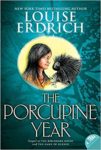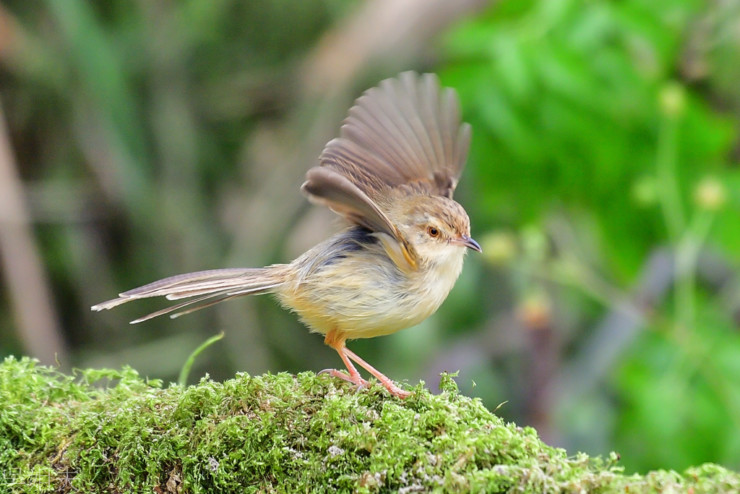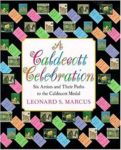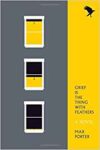Just as there are summer movies, there are also summer books—the kind to read beside the pool, to listen to on a cross-country drive, and to curl up with on a porch alongside the drumbeat of a summer thunderstorm. Or maybe you’re like me: You take an 821-page volume to the beach.
At Tweetspeak, books matter, whether they are tomes or picture books. We host book clubs, we review books, and we publish them at T.S. Poetry Press. We’re dedicated to literacy — for life.
Do you want to be a wild reader? Are you reading wildly already? We’re using Donalyn Miller’s Reading in the Wild: The Book Whisperer’s Keys to Cultivating Lifelong Reading Habits to explore what it means to be a wild reader — someone most likely to embrace literacy for life. Read through these five characteristics and see which ones fit your reading style and which you might incorporate this month. Or add your own category.
5 Main Characteristics of Wild Readers

The book I took to the beach this year was a short story collection, Uncommon Type, by Tom Hanks. There is a Tom Hanks-ness to these stories, a measure of kindness even when the plot is dark. As to genre, the stories are all over the map, but each one features a typewriter. One of the best ones, a DIY moon launch titled “Alan Bean Plus Four,” was published in The New Yorker a few years ago. (Sidenote: Alan Bean passed away in June.) Here is a great sentence from that story: “Once we crossed, the moon grabbed hold, wrapping us in her ancient silvery embrace, whispering to us to hurry hurry hurry to wink in wonder at her magnificent desolation.”
2. They self-select reading material.
I read two books by Louise Erdrich this month and ordered a third. Erdrich can do it all: poetry, adult fiction, children’s fiction, short stories, nonfiction. Future Home of the Living God is a dystopian novel, which made it a good choice for Tweetspeak’s June emphasis on science fiction. When Erdrich, who is a member of the Turtle Mountain Band of Chippewa Indians, writes about Chippewa/Ojibwe, she often subverts expectations. For example, the main character’s name, given to her by her adoptive family, is Cedar Hawk Songmaker. Her Ojibwe birth name is Mary Potts. My favorite parts of the story explore what effects an end-of-the-world scenario might have on America’s tribal nations, especially those with strong Catholic traditions.

The other book by Erdrich I read was The Porcupine Year, the third in a series called Birchbark House. Think of the Little House series, but starring an Ojibwe girl. In this story Omakayas and her family travel from their island home, Madeline Island on Lake Superior, to a new one on Lac Du Bois. During this year-in-the-life story, Omakayas decides what kind of person she wants to be. When faced with many examples, she chooses to follow this one: “She had known exactly how long to live. When her life would count the most, she freely gave it. She was proof, in her love, of a love greater than we know.” I’ve already shared my excitement for this series with a friend who loves children’s fiction, especially a series she can sink into over the summer.
I love books that recommend other books, thus giving me a miniature reading plan. A Caldecott Celebration: Six Artists and Their Paths to the Caldecott Medal by Leonard S. Marcus is a short reference book for kids, written back in 1998 to celebrate the 60th anniversary of the Caldecott Medal. I reread the four winners I was familiar with and read the other two I’d missed. It’s an example of a reference book for children, with a list of the Caldecott winners from 1938-1988 and a glossary of artistic terms. It also has great quotes from the illustrators, including this one by Maurice Sendak: “Where the Wild Things Are was not meant to please everybody—only children.”
5. They show preferences.
Looking for a book rec? Try Tweetspeak Poetry! In February, Glynn Young reviewed Max Porter’s Grief Is the Thing with Feathers, and I put it on my list. Glynn was right when he said, “Physically, the text looks like a poetry collection. Sort of.” There are poems. There are letters. There is prose. There are comprehension questions. The words “Once upon a time” occur nine times. The voices shift between Dad, Crow, and Boys. After Mum/Wife dies, leaving the day and two boys alone, their masculinity moves forward. Dad is a Ted Hughes scholar, writing “Ted Hughes’ Crow on the Couch: A Wild Analysis.” Crow is crude and sometimes cruel, but he helps this motley crew. I think the boys are the best part. We see them both younger and older, in grief and avoiding grief, goading each other and taking care of/taking advantage of their dad. One of the boys, now grown up, says this:
My wife shakes her head. She thinks it’s
weird that I fondly remember family
holidays with an imaginary crow, and
I remind her that it could have been
anything, could have gone any way, but
something more or less healthy happened.
We miss our Mum, we love our Dad, we
wave at crows.It’s not that weird.”
I’ve already started rereading this one, a poem at a time. It’s not that weird, right, to reread things we love?
June’s Pages
Finished
Adult
Future Home of the Living God, Louise Erdrich
Uncommon Type, Tom Hanks
The Art of Gathering, Priya Parker (the most recent Tweetspeak book club selection)
Grief Is the Thing with Feathers, Max Porter
The Looming Tower, Lawrence Wright (finished from last month)
Early Readers and Picture Books
Wolfie the Bunny, Ame Dyckman, illus. Zachariah Ohora
Lost and Found, Oliver Jeffers
Make Way for Ducklings, Robert McCloskey
May I Bring a Friend?, Beatrice Schenk de Regniers, illus. Beni Montresor (our Children’s Book Club selection for next week, July 13)
Sylvester and the Magic Pebble, William Steig
Jumanji, Chris Van Allsburg
Tuesday, David Wiesner
Middle Grade and YA
The Porcupine Year, Louise Erdrich
A Caldecott Celebration, Leonard S. Marcus
Sliced (Got what I needed and moved on or plan to finish someday.)
Nope
Abandoned (Not my cup of tea, it bogged down quickly, or others beckoned.)
Nope
Started (Will I finish? Of course!)
No god but God, Reza Aslan
Song of Ice and Fire: A Game of Thrones, George R.R. Martin
Photo by 姐夫 吳, Creative Commons, via Flickr. Post by Megan Willome, author of The Joy of Poetry.
Browse more Reading in the Wild
“Megan Willome’s The Joy of Poetry is not a long book, but it took me longer to read than I expected, because I kept stopping to savor poems and passages, to make note of books mentioned, and to compare Willome’s journey into poetry to my own. The book is many things. An unpretentious, funny, and poignant memoir. A defense of poetry, a response to literature that has touched her life, and a manual on how to write poetry. It’s also the story of a daughter who loses her mother to cancer. The author links these things into a narrative much like that of a novel. I loved this book. As soon as I finished, I began reading it again.”
—David Lee Garrison, author of Playing Bach in the D. C. Metro
- Perspective: The Two, The Only: Calvin and Hobbes - December 16, 2022
- Children’s Book Club: A Very Haunted Christmas - December 9, 2022
- By Heart: ‘The night is darkening round me’ by Emily Brontë - December 2, 2022





Glynn says
I really liked “Grief is the Thing with Feathers.” And that 821-page book to bring to the beach? I read it, years ago, but not at the beach. What a story! The only book I can recall reading at the beach is “Don Quixote.” We had decided on a do-nothing vacation and sitting on a beach, and that’s what we did down in Orange Beach, Alabama. Every morning for a week, I walked from our beach hotel to the beach, rented my beach umbrella and chair, and alternated between watching waves and tilting at windmills. It was wonderful.
My reading in June:
Fiction
Send Down the Rain by Charles Martin
The Red House by Mark Haddon
War Horse by Michael Morpurgo
A Garden in Paris and A Hill in Tuscany by Stephanie Grace Whitman
Mystery
Murder at the Bridge by Frances Evesham
A Whiff of Cyanide by Guy Fraser-Sampson
Twist of Faith by Ellen Green
The Tango School Mystery by Peter Bartram
Dead Water by Ann Cleeves
The Dragons of Alsace Farm
Faith
Why Jesus? by Ravi Zacharias
Are People Basically Good? by R.C. Sproul
Sonship by Jay Cookingham
Increase Your Faith by Raj Ashok
Poetry
Eye Level by Jenny Xie
For the Union Dead by Robert Lowell
Collected Poems by Allen Tate
Drum Taps: The Civil War Poems of Walt Whitman
Kiss the Earth by Neal Sehgal
I hope this reaches her in time by r.h. Sin (yes, that’s how he spells it)
Non-fiction
The Great Revolt by Salena Zito and Brad Todd
Grant and Twain by Mark Perry
Megan Willome says
I absolutely love the idea of “Don Quixote” as a beach read. I have not read it since high school Spanish, where we read it in Spanish.
Will Willingham says
I might check into the Hanks collection. I didn’t know he had one. But a little bit of his kindness might be just the thing. 🙂
Megan Willome says
I highly recommend it, LW. It did my soul good, regardless of whether the plot ended in a happily-ever-after place or not. And it’s fun to watch for the typewriters–sometimes they play a big role, and sometimes they’re just part of the scenery.
L.L. Barkat says
I agree with LW. That Hanks is looking like a good possibility. (And, it seems like a fun writing project, to create a collection where an object keeps showing up. Say, like that typewriter.)
I started The Twenty-One Balloons. Fun and strange story. 🙂
Still reading The Art of Gathering. Still reading The Golem and the Jinni.
But? I finished Bonsoir Lune and La chasse à l’ours. 😉
Megan Willome says
Yes, it is fun and strange. I can see why it endures because I think it’s wackiness appeals to kids.
What are the French books?
L.L. Barkat says
Goodnight Moon and Going on a Bear Hunt. Both here because Sonia is taking French in the fall, and I promised to study along with her to give her a bit of camaraderie in what otherwise will be not so fun for her. She’s loving taking the children’s book approach, dipping her summer toes into French before class starts in September. 🙂
Megan Willome says
Oh, what fun!
Glynn says
My grandsons love Going on a Bear Hunt. When I ask them if they want me to read it, the six-year-old shouts “NO! They’re going to find a BEAR!” So, I start reading, and he sits next to me and listens. This has become something of a ritual with the book.
Megan Willome says
Books make great rituals.
Laura Lynn Brown says
Reread:
Holy the Firm by Annie Dillard
Bits and pieces of Breath for the Bones, The Crime of Living Cautiously, A Prayerbook for Spiritual Friends and various poetry collections by Luci Shaw
Still reading:
The Art of Gathering by Priya Parker
Culture Making by Andy Crouch
Whiskey, Etc. by Sherrie Flick (flash fiction)
On Homesickness: A Plea by Jesse Donaldson (the kind of book I wish I’d thought of)
Vacationland by John Hodgman
Skimming for class prep:
Writing that Works: Communicating Effectively on the Job by Oliu, Brusaw & Alred
Megan Willome says
Laura, how’s the John Hodgman?
Laura Lynn Brown says
If you’ve encountered his work (in writing, on his podcast, on TV), you know he has a distinctive voice, the kind that people generally either really like or really don’t. I’m enjoying the parts where he writes about inheriting his parents’ vacation home in western Massachusetts and muses on middle age. It’s less of the constructed persona of John Hodgman and more of the real guy. And it occasionally makes me laugh out loud.
Megan Willome says
I am somewhat familiar with Hodgman’s voice–my favorite is his TV pilot from the “Dead Pilots Society” podcast. I think I would like more of the real guy.
Laura Lynn Brown says
Then read this for the “What to do with an inherited house? I guess I’ll keep it, deal with all my associations with and feelings about it and its contents, and learn mysterious adulting tasks like ordering propane and hauling my own trash” parts and skip the rest.